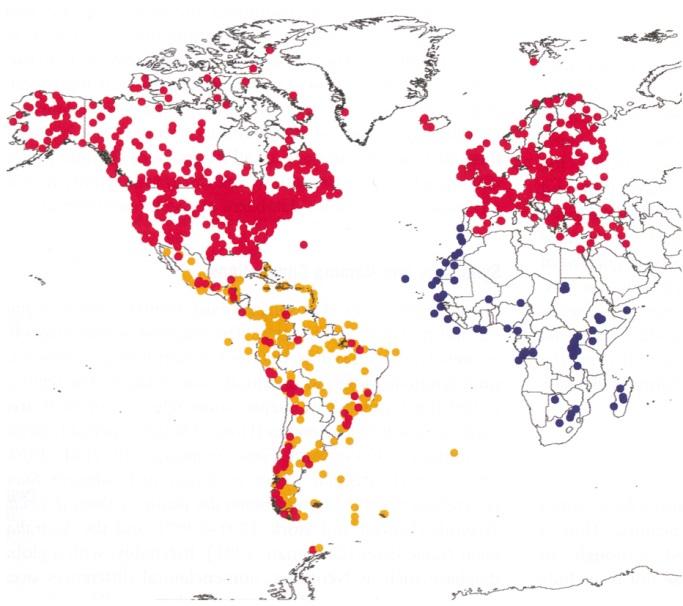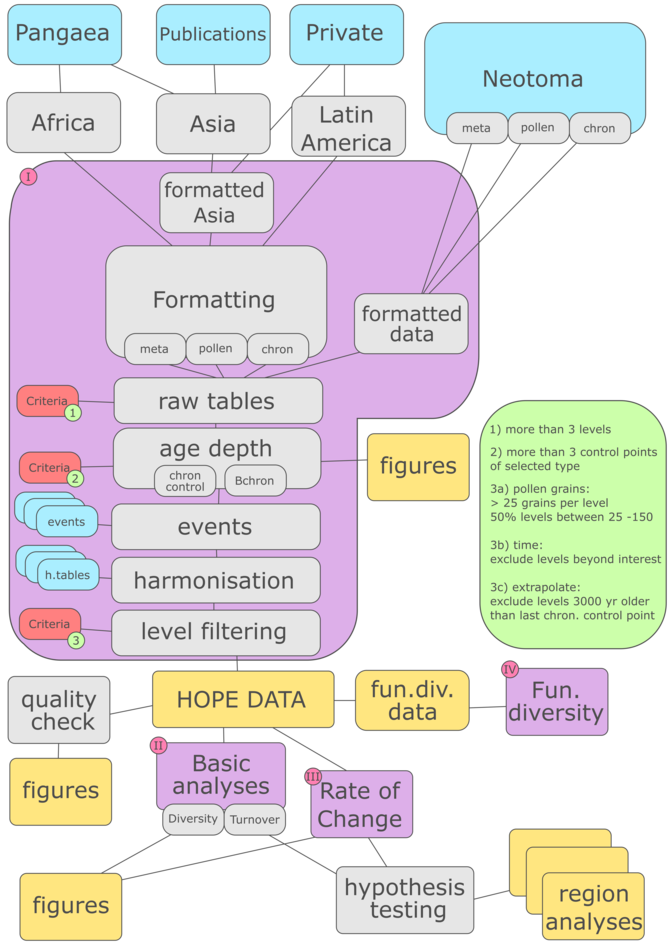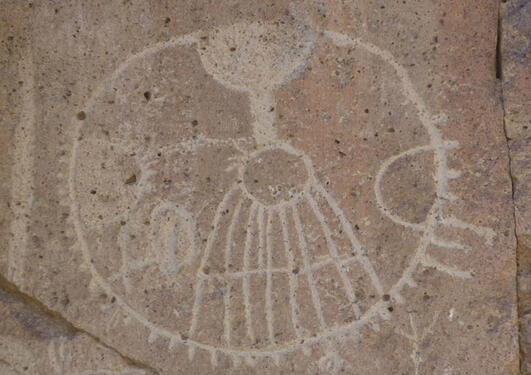HOPE
Humans on Planet Earth - Long-term impacts on biosphere dynamics (HOPE) is a 6.5-year European Research Council Advanced Grant project running from 1 January 2018 to 30 June 2024. It addresses a critical question in Earth system science - what was the impact of prehistoric people on the biosphere and its dynamics?

Main content
What are biosphere dynamics?
‘Biosphere dynamics’ are the ecological and evolutionary changes that occur as biological systems respond to, and contribute to, environmental change. They encompass many processes, e.g. population growth rates, shifts in range, changes in biogeochemical cycling, community composition changes, speciation, and extinctions at a range of spatial and temporal scales. HOPE concentrates on ‘ecological dynamics’ – the changes and interactions in the Earth life system expressed as changes in taxon distributions and abundances and in environment. Ecosystems and communities have many properties such as composition, abundance, richness, diversity, evenness, turnover, co-occurrence, etc. In HOPE these are called ‘ecosystem or ecological properties’ and represent HOPE’s major research focus.
Pollen analysis and human impact
It is over 70 years since Johs Iversen, using pollen analysis, first demonstrated the influence of prehistoric people on vegetation with forest clearance, ‘slash and burn’, and cereal cultivation. The advent of radiocarbon dating in the early 1950s provided an absolute chronology for Holocene research. There are now many hundreds of detailed, dated pollen studies focussing on human impact on past vegetation, primarily in Europe but also in North America, South America, and Africa. These studies primarily concern the spatial extent and timings and duration of disturbance or clearance episodes; the nature of early agricultural and other land-use practices; the quantitative estimation of past vegetation for land-cover reconstructions; the role of human impact through fire and clearances in influencing tree invasion or decline and hence forest composition; the development of ‘cultural landscapes’ and associated landscape diversity; and the role of human impact on island biota through forest clearance and tree extinctions and introduction of exotic taxa. Many studies integrate pollen analysis with archaeology, dynamic vegetation modelling, palaeo-limnology, and/or complex systems science to explore societal-environment relationships or to quantify sustainability, soil erosion and catchment degradation, changes in hydrology and nutrient cycling, and landscape resilience.
As a result of the very large numbers of such pollen-analytical studies, there is now a rich source of long-term data on patterns of prehistoric human impact on the composition of past vegetation, landscape changes, and environment (‘the face of the Earth’) and also for times without human impact. There are, however, surprisingly few data on human impact on Earth systems and ecological processes . Pollen-analytical studies very rarely consider the potential role of human activity in influencing the major determinants of community ecology and structure, such as assembly rules, taxon co-occurrences, functional diversity, or historical legacies, all of which are of fundamental importance in understanding contemporary community ecology and hence in predicting future biotic responses in an uncertain ‘Anthropocene’ world. HOPE focuses on assessing the role that human activity during the Holocene has had on the major determinants of community assembly, structure, and dynamics over a range of spatial scales ranging from continents and biomes, to individual pollen sites, namely processes underlying the observed patterns.
A major recent development in Quaternary pollen analysis has been the creation of open-access databases of pollen-analytical data and associated site and dating information along with state-of-the-art user-friendly software to help access and extract data-sets. Systematic compilation of pollen data started in the COHMAP project and has continued as part of the Past Global Changes (PAGES) research agenda and associated programmes. There are now databases for Europe, North America, South America, and Africa. Some are currently being integrated into the Global Pollen Database (GPD) within the Neotoma database. The GPD and the individual continental or sub-continental databases currently contain data from 5000+ stratigraphical sequences and 8000+ modern surface samples. Considerable effort has gone into producing robust age-depth models for the pollen sequences in these databases. These pollen databases are a major research resource as they contain unique pollen data that are very time consuming to collect and associated chronological information that is expensive to acquire. They provide a critical mass of data essential for many novel global- and continental-scale projects, including HOPE.
HOPE will also take advantage of recent published syntheses of the spatio-temporal distribution of Holocene human populations in Europe and south-west Asia, North America, South America, and Africa to provide a factual information-base to assess if changes in ecosystem properties are related temporally and spatially to prehistoric human activity.
Objectives
HOPE has two major objectives.
- To test the recently proposed hypothesis that prehistoric human impact about 6000 years ago altered the fundamental ecological processes which determine the assembly, ecological structure, and dynamics of terrestrial plant communities. Proponents of this hypothesis argue that the use of past ‘natural experiments’ and of the past as an analogue to the uncertain future of Earth in the ‘Anthropocene’ is a ‘flawed strategy’ and uniformitarianism should be discarded. As much of Earth system science relies on such ‘natural experiments’ and depends on the concept of uniformitarianism, it is clearly imperative to test critically and robustly this hypothesis and related arguments and far-reaching conclusions.
- To test the associated hypothesis that the inter-relationships (correlations) between estimates of ecosystem properties such as turnover, taxonomic and functional diversity, and co-occurrence patterns changed during the Holocene in response to prehistoric human activities.
To test these hypotheses, patterns in multivariate pollen-stratigraphical data from over 2000 lakes or mires in Africa, south-west Asia, Europe, North America, and South America will be explored in a consistent manner using state-of-the-art numerical techniques to discern temporal patterns in 25 ecosystem properties. Temporal, spatial, and correlation patterns in these properties will be compared statistically within each site, between sites within biomes, between biomes within continents, and between biomes on different continents using statistical techniques such as generalised Procrustes analysis and generalised linear mixed or additive mixed modelling with model-simulated climate variables and disturbance events as predictors. Testing of the two hypotheses underlying HOPE will be based on the results of these statistical procedures.
HOPE is by necessity a multi-disciplinary project, involving pollen analysis, databases, archaeology, numerical and statistical data analysis, modern biogeography and ecology, and data-storage.
Methodology
Thanks to advances in numerical and statistical methods, HOPE will use state-of-the-art techniques such as multivariate regression trees (MRT) and principal curves to summarise major patterns within single pollen sequences. Specialised techniques will estimate characteristics of the pollen assemblages (‘ecosystem properties’) such as richness, diversity, evenness, and beta-diversity, along with compositional turnover and rates of change. Advanced statistical methods will assist in data interpretation and synthesis and HOPE will use reduced-rank multivariate regression, variation partitioning, Procrustes analysis, permutation tests, and generalised linear and additive mixed regression modelling to test the two basic hypotheses.
The processes involving extrinsic environmental factors, intrinsic interactions, and neutral processes in the assembly and control of community composition, structure, and dynamics are hotly debated by contemporary community ecologists. They are not mutually exclusive and probably operate simultaneously to varying degrees. Environmental filtering, species interactions, and dispersal limitation are probably all important in different contexts. The challenge of understanding community processes arises from the general problem in observational sciences of inferring underlying unobservable processes from observable patterns such as, in this case, species composition or co-occurrences. Species co-occurrences are increasingly used to infer drivers of community assembly. HOPE will develop new, more powerful techniques for co-occurrence analysis utilising quantitative 'closed' pollen percentage data that avoid misleading ‘false positives’ resulting from ‘presences’ (but low values) of pollen of highly over-represented taxa such as Pinus or Artemisia. HOPE will also estimate over 20 other ecological properties of 2000+ pollen sequences from five continents.
Patterns in these properties will be compared statistically at sites within biomes, between biomes, within continents, and between continents to test the hypotheses that prehistoric human activities changed the basic ecological processes of community assembly and that their inter-relationships changed through time. These areas provide major contrasts in human prehistory and biomes.
Synthesis involves compiling for each sequence the estimates of the 25 different ecosystem properties and plotting them as temporal series along with ages and data about past disturbances. The occurrence of statistically significant change-points in each series will be detected by regression trees with generalised cross-validation. The total number of significant change-points will be evaluated against a random model to test if changes in ecosystem properties are aggregated or segregated, and are linked to disturbance events (hypothesis 1). Syntheses will be made for sites, within biomes, between biomes on the same continent, and between related biomes on different continents. The results will be mapped to explore spatial patterns in the properties. Statistical modelling of properties at a site in relation to disturbance, past climate simulations, and location, using novel techniques will allow a critical and robust testing of hypothesis 1 underlying HOPE, Preliminary modelling will use reduced-rank multivariate regression, permutation tests, and unbiased variation partitioning. More detailed modelling using all sites will be made using generalised linear mixed and generalised additive mixed modelling with state-of-the-art model-fit and model-selection criteria, with allowances for spatial and temporal autocorrelation. Changes in the correlation structure (hypothesis 2) of the 25 properties with time will be tested at different spatial scales using classical and generalised Procrustes analysis and associated permutation tests. Both hypothesis 1 and 2 will be evaluated at various spatial scales assuming there are sufficient data – all five continents, individual continents (SW Asia included with Europe), and individual biomes or major vegetation regions. These various spatial scales will allow for the fact that some parts of Earth have been subjected to human activity for very different durations and intensities. Regional ‘dashboards’ summarising changes in ecosystem properties will be constructed to help link HOPE’s results with Earth system trends in an easily intelligible form.
The HOPE team
The HOPE team consists of late, mid, and early career researchers including three post-docs and one associated PhD student.
HOPE's PI is John Birks, assisted by Alistair Seddon, John-Arvid Grytnes, Hilary Birks, and Cathy Jenks. Suzette Flantua the first post-doc started in April 2018 and ended in November 2021, Vivian Felde began as a researcher in January 2019, post-doc Kuber Bhatta started in March 2019, and post-doc Ondrej Mottl started in February 2020 and ended in May 2023. Technical help in Bergen is provided by Arild Breistøl and Linn Krüger. Arnaud Gallou started his PhD in January 2019 linked to the HOPE project and is supervised by John-Arvid Grytnes and Suzette Flantua. International collaborators include Cajo ter Braak, Fahu Chen, Thomas Giesecke, Eric Grimm+, Simon Haberle, Henry Hooghiemstra, Sandra Nogué, Triin Reitalu, Petr Smilauer, Jack Williams, Janet Wilmshurst, and Yan Zhao. Manuel Steinbauer had a 10% position with the HOPE team from January 2020 to December 2022. HOPE had close links with the IGNEX-eco and IGNEX projects.
HOPE's hopes
HOPE should hopefully tell us if prehistoric humans did alter the fundamental ecological processes of community ecology, whether the interrelationships between properties have changes, whether using 'natural experiments' is a 'flawed strategy', and most important of all, whether uniformitarianism - the present is the key to the past - can be maintained as a fundamental working concept in Earth system science. Is the past a foreign country or is the past essential (and inescapable) and without it the present would make no sense? Time is, after all, a continuum, and today is yesterday's tomorrow.
Publications
Bhatta, K.P., Mottl, O., Felde, V.A., Flantua, S.G.A., Birks, H.H., Cao, X., Chen, F., Grytnes, J.-A., Seddon, A.W.R. & Birks, H.J.B. (2023) Exploring spatio-temporal patterns of palynological changes in Asia during the Holocene. Frontiers in Ecology and Evolution 11: 1115784. 10.3389/fevo.2023.1115784
Birks, H.H. (2023) Macrofossils and pollen. In: Lang, G., Ammann, B., Behre, K.-E. & Tinner, W. (Eds) Quaternary Vegetation Dynamics of Europe. Haupt, pp. 33-35.
Birks, H.J.B. (2023) Vegetation history, evolution, and modern ecology. In: Lang, G., Ammann, B., Behre, K.-E. & Tinner, W. (Eds) Quaternary Vegetation History of Europe. Haupt, pp. 503-528.
Birks, H.J.B., Bhatta, K.P., Felde, V.A., Flantua, S.G.A., Mottl, O., Haberle, S.G., Herbert, A., Hooghiemstra, H., Birks, H.H., Grytnes, J.-A. & Seddon, A.W.R. (2023) Approaches to pollen taxonomic harmonisation in Quaternary palynology. Review of Palaeobotany and Palynology 319: 104989. 10.1016/j.revpalbo.2023.104989
Flantua, S.G.A. & Hooghiemstra, H. (2023) Anthropogenic pollen indicators: global food plants and Latin American human indicators in the pollen record. Scientific Data 10: 721. 10.1038/s41597-023-02613-1
Flantua, S.G.A., Mottl, O., Felde, V.A., Bhatta, K.P., Birks, H.H., Grytnes, J.-A., Seddon, A.W.R. & Birks, H.J.B. (2023) A guide to the processing and standardization of global palaeoecological data for large-scale syntheses using fossil pollen. Global Ecology and Biogeography 32: 1377-1394. 10.1111/geb.13693
Zurell, D., Fritz, S.A., Rönnfeldt, A. & Steinbauer, M.J. (2023) Predicting extinctions with species distribution models. Cambridge Prisms: Extinction 1: e8. 10.1017/ext.2023.5
Githumbi, E., Fyfe, R.M., Gaillard, M.-J., Trondman, A.-K. and 15 co-authors and many LandClimII data contributors including Birks, H.J.B. and Bjune, A.E. (2022) European pollen-based REVEALS land-cover reconstructions for the Holocene: methodology, mapping and potentials. Earth System Science Data 14: 1581-1619. 10.5194/essd-14-1581-2022
Hooghiemstra, H., Perez, G.S., Torres, V.T., Berrio, J.C., Lourens, L. & Flantua, S.G.A. (2022) 60 years of scientific deep drilling in Colombia: the north Andean guide to the Quaternary. Scientific Drilling 30: 1-15. 10.5194/sd-30-1-2022
Sales, R.K., McMichael, C.N.H., Flantua, S.G.A., Hagemans, K., Zondervan, J.R., Gonzalez-Arango, C., Church, W.B. & Bush, M.B. (2022) Potential distributions of pre-Columbian people in tropical Andean landscapes. Philosophical Transactions of the Royal Society B 377: 20200502. 10.1098/rstb.2020.0502
Tovar, C., Carril, A.F., Gutierrez, A.G. and 22 co-authors including Flantua, S.G.A. (2022) Understanding climate change impacts on biome and plant distributions in the Andes: challenges and opportunities. Journal of Biogeography 49: 1420-1442. 10.1111/jbi.14389
Williams, J.W., Huntley, B. & Seddon, A.W.R. (2022) Climate sensitivity and ecoclimate sensitivity: theory, usage, and past implications for the future biospheric responses. Current Climate Change Reports 8: 1-16- 10.1007/s40641-022-00179-5
Bhatta, K.P., Robson, B.A., Suwal, M.K. & Vetaas, O.R. (2021) A pan-Himalayan test of predictions on plant species richness based on primary production and water-energy dynamics. Frontiers of Biogeography 13.3: e49459. 10.21425/F5FBG49459
Bhatarai, P., Zheng, Z., Bhatta, K.P., Adhikari, Y.P. & Zhang, Y. (2021) Climate-driven plant response and resilience on the Tibetan Plateau in space and time: a review. Plants 10: 480. 10.3390/plants10030480
Birks, H.J.B. (2021) High-elevation limits and the ecology of high-elevation vascular plants: legacies from Alexander von Humboldt. Frontiers of Biogeography 13.3: e53226. 10.21425/F5FBG53226
Brovkin, V., Brook, E., Williams, J.W. and 28 co-authors including Seddon, A.W.R. (2021) Past abrupt changes, tipping points and cascading impacts in the Earth system. Nature Geoscience 14: 550-558. 10.1038/s41561-021-00790-5
Mathes, G.H., van Dijk, J., Kiessling, W., Steinbauer, M.J. (2021) Extinction risk controlled by interaction of long-term and short-term climate change. Nature Ecology & Evolution 5: 304-310. 10.1038/s41559-020-01377-w
Mottl, O., Flantua, S.G.A., Bhatta, K.P., Felde, V.A., Giesecke, Goring, S., Grimm, E.C., Haberle, S., Hooghiemstra, H., Ivory, S., Kuneš, P., Wolters, S., Seddon, A.W.R. & Williams, J.W. (2021) Global acceleration in rates of vegetation change over the past 18,000 years. Science 372: 860-864. 10.1126/science.abg1685 Erratum
Mottl, O., Grytnes, J.-A., Seddon, A.W.R., Steinbauer, M.J., Bhatta, K.P., Felde, V.A., Flantua, S.G.A. & Birks, H.J.B. (2021) Rate-of-change analysis in palaeoecology revisited: a new approach. Review of Palaeobotany and Palynology 293; 104483. 10.1016/j.revpalbo.2021.104483
Nogué, S., Santos, A.M.C., Birks, H.J.B. and 19 co-authors including Felde, V.A. & Steinbauer, M.J. (2021) The human dimension of biodiversity changes on islands. Science 372: 488-491. 10.1126/science.abd6706
Seddon, A.W.R. (2021) Measuring components of ecological resilience in long-term ecological datasets. Biology Letters 17: 20200881. 10.1098/rsbl.2020.0881
Benito, B.M., Gil-Romera, G. & Birks, H.J.B. (2020) Ecological memory at millennial time-scales: the importance of data constraints, species longevity and niche features. Ecography 43: 1-10. 10.1111/ecog.04772
Benito, B.M. & Birks, H.J.B. (2020) distantia: an open-source toolset to quantify dissimilarity between multivariate ecological time-series. Ecography 43: 660-667. 10.1111/ecog.04895
Birks, H.J.B. (2020) Reflections on the use of ecological attributes and traits in Quaternary botany. Frontiers in Ecology & Evolution 8: 166. 10.3389/fevo.2020.00166
Felde, V.A., Flantua, S.G.A., Jenks, C.R., Benito, B., de Beaulieu, J.-L., Kuneš, P., Magri, D., Nalepka, D., Risebrobakken, B., ter Braak, C.J.F., Allen, J.R.M., Granoszewski, W., Helmens, K.F., Huntley, B., Kondratienė, O., Kalniņa, L., Kupryjanowicz, M., Malkiewicz, M., Milner, A.M., Nita, M., Noryśkiewicz, B., Pidek, I.A., Reille, M., Salonen, J.S., Šeirienė, V., Winter, H., Tzedakis, P.C. & Birks, H.J.B. (2020) Compositional variation and turnover in Eemian pollen sequences in Europe. Vegetation History and Archaeobotany 29: 101-109. 10.1007/s00334-019-00726-5
Gauzere, P., Iversen, L., Seddon, A.W.R., Ville, C. & Blonder, B. (2020) Equilibrium in plant functional trait responses to warming is stronger under higher climate variability during the Holocene. Global Ecology and Biogeography 29: 2052-2066. 10.1111/geb.13176
Nürk, N.M., Linder, H.P. and 16 co-authors including Flantua, S.G.A. (2020) Diversification in evolutionary arenas - assessment and synthesis. Ecology & Evolution 10: 6163-6182. 10.1002/ece3.6313
Zhao, Y., Tzedakis, P.C., and 19 co-authors including Birks, H.J.B. & Felde, V.A. (2020) Evolution of vegetation and climate variability on the Tibetan Plateau over the past 1.74 million years. Science Advances 6: eaay6193. 10.1126/sciadv.aay6193
Birks, H.J.B. (2019) Contributions of Quaternary botany to modern ecology and biogeography. Plant Ecology and Diversity 12: 189-385. 10.1080/17550874.2019.1646831
Felde, V.A. & Birks, H.H. (2019) Using species attributes to characterize late-glacial and early-Holocene environments at Kråkenes, western Norway. Journal of Vegetation Science 30: 1228-1238. 10.1111/jvs.12804
Reitalu, T., Bjune, A.E., Blaus, A., Giesecke, T., Helm, A., Matthias, I., Peglar, S.M., Salonen, J.S., Seppä, H., Väli, V. & Birks, H.J.B. (2019) Patterns of modern pollen and plant richness across northern Europe. Journal of Ecology 107: 1662-1677. 10.1111/1365-2745.13134


